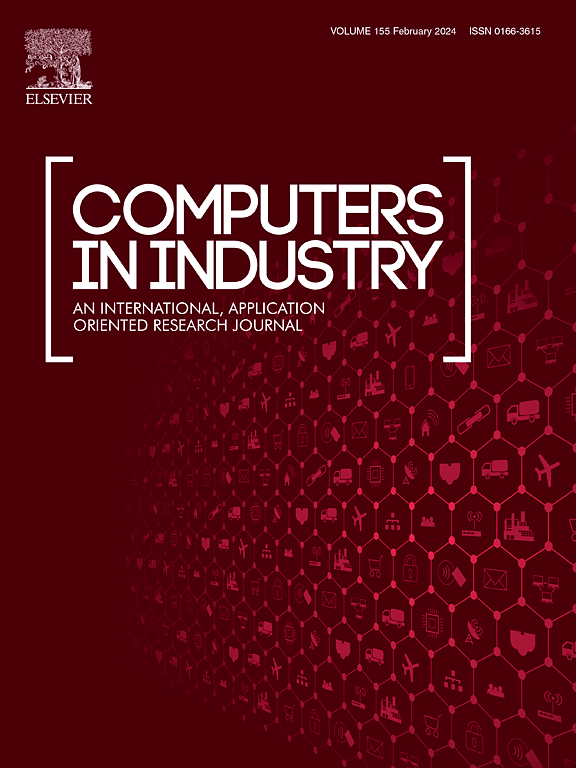Physics-informed digital twin design for supporting the selection of process settings in continuous manufacturing, with a focus in fiberboard production
IF 8.2
1区 计算机科学
Q1 COMPUTER SCIENCE, INTERDISCIPLINARY APPLICATIONS
引用次数: 0
Abstract
In process industry, plant operators often rely on their experience to choose suitable process settings that meet the productivity and quality goals. When these goals are not met, multiple changes to the settings might be necessary, which is time-consuming because each adjustment requires waiting for the new steady-state condition. A digital twin that quickly provides key performance indicators in steady-state as a function of these settings can speed up this task. The settings can be manually simulated before being adopted, or the digital twin can be integrated into an optimizer to automatically suggest optimal values to the operator, who ultimately makes the final decision. Despite advances in approaches to design such digital twins, most studies lack strategies to update the models when the plant behavior changes, and often overlook constraints and human-centric aspects of the plant operation. To address these gaps, we present a framework for training, tuning, and updating models for supporting the selection of process settings in continuous manufacturing. By directly mapping the steady-state conditions as a function of process settings, our approach enables informed decision-making and paves the way towards process optimization without requiring modifications to the plant control software, a crucial factor in established plants to ensure safety. We propose an interpretable model architecture, and a training process that incorporates both data and prior physical knowledge. Triggers detect deviations between the models’ predictions and the plant condition, in order to start model updates. The procedure for updating the models is tuned to perform consistently well in a variety of conditions, based on substantial simulations in historical data. To select the triggers, we balance technical and human aspects, by considering the trade-off between frequent model updates, increasing operator workload with frequent settings changes, versus how closely the models track the plant conditions. The framework is applied to five different stages of the fiberboard production process in a 1.4-year dataset, to predict key energy and quality-related variables as a function of process settings. The results show that the models, when connected to the data stream, are effectively updated when needed, show high sensitivity to the process settings and consistency with the available physical knowledge, making them well-suited to support the selection of process settings.
基于物理的数字孪生设计,支持连续制造过程设置的选择,重点是纤维板生产
在过程工业中,工厂操作员通常依靠他们的经验来选择合适的工艺设置,以满足生产力和质量目标。当这些目标没有达到时,可能需要对设置进行多次更改,这很耗时,因为每次调整都需要等待新的稳态条件。作为这些设置的功能,数字孪生可以快速提供稳定状态下的关键性能指标,从而加快这项任务。这些设置可以在采用之前进行手动模拟,或者可以将数字孪生集成到优化器中,自动向操作人员提供最佳值,最终由操作人员做出最终决定。尽管设计这种数字双胞胎的方法取得了进展,但大多数研究缺乏在植物行为发生变化时更新模型的策略,并且往往忽视了植物操作的约束和以人为中心的方面。为了解决这些差距,我们提出了一个培训、调整和更新模型的框架,以支持连续制造中工艺设置的选择。通过直接将稳态条件映射为过程设置的函数,我们的方法可以实现明智的决策,并为过程优化铺平道路,而无需修改工厂控制软件,这是已建立工厂确保安全的关键因素。我们提出了一个可解释的模型架构,以及一个结合数据和先前物理知识的训练过程。触发器检测模型预测和工厂状况之间的偏差,以便启动模型更新。基于对历史数据的大量模拟,对模型更新过程进行了调整,使其在各种条件下都能保持良好的性能。为了选择触发器,我们考虑了频繁的模型更新,频繁的设置更改增加了操作员的工作量,以及模型跟踪工厂条件的密切程度之间的权衡,从而平衡了技术和人员方面的因素。该框架应用于1.4年数据集中纤维板生产过程的五个不同阶段,以预测关键的能源和质量相关变量作为工艺设置的函数。结果表明,当模型连接到数据流时,可以在需要时有效地更新,对工艺设置具有高灵敏度,并且与现有物理知识保持一致,使其非常适合支持工艺设置的选择。
本文章由计算机程序翻译,如有差异,请以英文原文为准。
求助全文
约1分钟内获得全文
求助全文
来源期刊

Computers in Industry
工程技术-计算机:跨学科应用
CiteScore
18.90
自引率
8.00%
发文量
152
审稿时长
22 days
期刊介绍:
The objective of Computers in Industry is to present original, high-quality, application-oriented research papers that:
• Illuminate emerging trends and possibilities in the utilization of Information and Communication Technology in industry;
• Establish connections or integrations across various technology domains within the expansive realm of computer applications for industry;
• Foster connections or integrations across diverse application areas of ICT in industry.
 求助内容:
求助内容: 应助结果提醒方式:
应助结果提醒方式:


